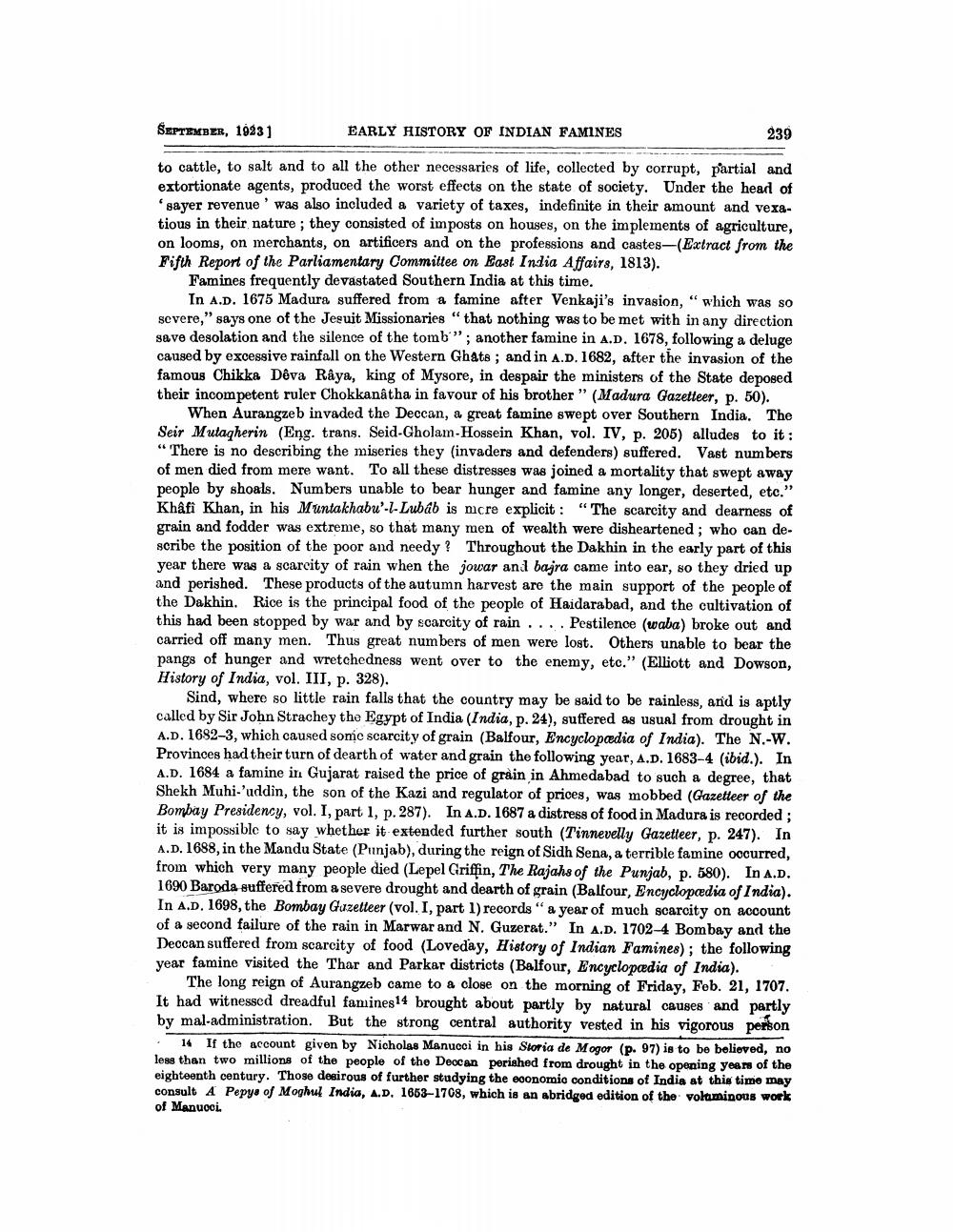________________
SEPTEMBER, 1923]
EARLY HISTORY OF INDIAN FAMINES
239
to cattle, to salt and to all the other necessaries of life, collected by corrupt, partial and extortionate agents, produced the worst effects on the state of society. Under the head of 'sayer revenue' was also included a variety of taxes, indefinite in their amount and vexatious in their nature; they consisted of imposts on houses, on the implements of agriculture, on looms, on merchants, on artificers and on the professions and castes-(Extract from the Fifth Report of the Parliamentary Committee on East India Affairs, 1813).
Famines frequently devastated Southern India at this time.
In A.D. 1675 Madura suffered from a famine after Venkaji's invasion, "which was so severe," says one of the Jesuit Missionaries "that nothing was to be met with in any direction save desolation and the silence of the tomb"; another famine in A.D. 1678, following a deluge caused by excessive rainfall on the Western Ghats; and in A.D. 1682, after the invasion of the famous Chikka Dêva Râya, king of Mysore, in despair the ministers of the State deposed their incompetent ruler Chokkanâtha in favour of his brother" (Madura Gazetteer, p. 50).
When Aurangzeb invaded the Deccan, a great famine swept over Southern India. The Seir Mutagherin (Eng. trans. Seid-Gholam-Hossein Khan, vol. IV, p. 205) alludes to it: "There is no describing the miseries they (invaders and defenders) suffered. Vast numbers of men died from mere want. To all these distresses was joined a mortality that swept away people by shoals. Numbers unable to bear hunger and famine any longer, deserted, etc." Khâfi Khan, in his Muntakhabu'-l-Lubab is mcre explicit: "The scarcity and dearness of grain and fodder was extreme, so that many men of wealth were disheartened; who can describe the position of the poor and needy? Throughout the Dakhin in the early part of this year there was a scarcity of rain when the jowar and bajra came into ear, so they dried up and perished. These products of the autumn harvest are the main support of the people of the Dakhin. Rice is the principal food of the people of Haidarabad, and the cultivation of this had been stopped by war and by scarcity of rain. ... Pestilence (waba) broke out and carried off many men. Thus great numbers of men were lost. Others unable to bear the pangs of hunger and wretchedness went over to the enemy, etc." (Elliott and Dowson, History of India, vol. III, p. 328).
Sind, where so little rain falls that the country may be said to be rainless, and is aptly called by Sir John Strachey the Egypt of India (India, p. 24), suffered as usual from drought in A.D. 1682-3, which caused some scarcity of grain (Balfour, Encyclopædia of India). The N.-W. Provinces had their turn of dearth of water and grain the following year, A.D. 1683-4 (ibid.). In A.D. 1684 a famine in Gujarat raised the price of grain in Ahmedabad to such a degree, that Shekh Muhi-'uddin, the son of the Kazi and regulator of prices, was mobbed (Gazetteer of the Bombay Presidency, vol. I, part 1, p. 287). In A.D. 1687 a distress of food in Madura is recorded; it is impossible to say whether it extended further south (Tinnevelly Gazetteer, p. 247). In A.D. 1688, in the Mandu State (Punjab), during the reign of Sidh Sena, a terrible famine occurred, from which very many people died (Lepel Griffin, The Rajahs of the Punjab, p. 580). In A.D. 1690 Baroda suffered from a severe drought and dearth of grain (Balfour, Encyclopædia of India). In A.D. 1698, the Bombay Gazetteer (vol. I, part 1) records "a year of much scarcity on account of a second failure of the rain in Marwar and N. Guzerat." In A.D. 1702-4 Bombay and the Deccan suffered from scarcity of food (Loveday, History of Indian Famines); the following year famine visited the Thar and Parkar districts (Balfour, Encyclopædia of India).
The long reign of Aurangzeb came to a close on the morning of Friday, Feb. 21, 1707. It had witnessed dreadful famines 14 brought about partly by natural causes and partly by mal-administration. But the strong central authority vested in his vigorous person
14 If the account given by Nicholas Manucci in his Storia de Mogor (p. 97) is to be believed, no less than two millions of the people of the Deccan perished from drought in the opening years of the eighteenth century. Those desirous of further studying the economic conditions of India at this time may consult A Pepys of Moghul India, A.D. 1653-1708, which is an abridged edition of the voluminous work of Manucci.




